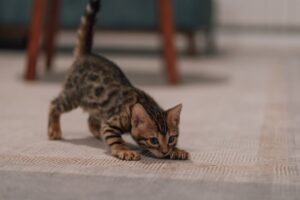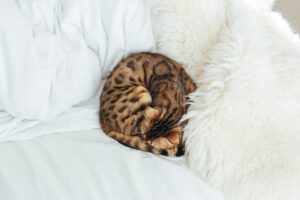Your Complete Guide to Bengal Kittens – Everything You Ever Needed to Know
Cats make adorable, loyal, hilarious, intelligent, and fascinating pets.
If you are a cat person, then you’ll know there is nothing quite like coming home to a house with a cat in it!
They’re elusive, yes, but they also make a fantastic company and can provide a calming and relaxing companionship.
So cats are great. But Bengal cats?
They’re arguably even greater!
These cats are well known for their tiger-like stripes and leopard-like spots, which really set them apart from other breeds.
This wild appearance is in stark contrast to their docile, playful, and friendly nature.
In short, they make fantastic pets!
In this complete guide, we’ll be taking a look at the history and nature of Bengal cats, and discussing how to look after and nurture your own new Bengal kitten.
Table of Contents
ToggleAll About Bengal Cats
The earliest Bengal cats date back to around 1889, where we first see mention of crossbreeds born from Asian leopard cats and domestic cats.
However, it was much more recently that breeder Jean Mill (who died in 2018) decided to breed a domestic cat with wild patterns proactively.
Mill is given credit for creating the modern breed, which was officially accepted by The International Cat Association in 1983.
From this point onward, Bengals exploded in popularity, and many variations on the wild-markings were introduced.
Bengal coats come in the following “designs”:
- Spotted rosette – This is the most popular pattern but can come in a variety of different colors, including black, red, brown, grey, and more. They can also be:
- Ticked
- Spotted
- Rosetted
- Clouded
- Marble – These Bengal cats have a distinct heritable pattern that includes blotched and spotted tabby markings.
Bengal cats are considered average-to-large for cats and tend to be lean and muscular.
They are typically smart, playful, and energetic – but also social.
Unlike many other breeds of cats, they actually enjoy playing in water!
In some parts of the US (such as New York City and Hawaii), these cats are outlawed.
Other areas have limits on Bengal ownership.
Caring For Your Bengal Kitten
The critical thing to remember is that while Bengal kittens are a domestic breed of cat, they aren’t that far removed from wild leopards.
That means that they yearn for activity, stimulation, and excitement.
In other words, one of the best things you can do for Bengal kittens is to play with them, buy them toys, and find ways to keep them stimulated!
Look for toys that simulate hunting – toy birds that they can swipe at or chase, or balls that they can roll around the floor.
Bengal cats also enjoy exploring their environment, and mainly the vertical.
Creating climbing posts for your cat can be a great way to keep them entertained and interested – even placing empty shelves on walls for them to stalk around!
Bengal cats are social, though not necessarily in a touchy-feely kind of way.
They like it when you are home, and they’ll usually want to be in the same room as you.
They can be noisy, though, and that can lead to some rude awakenings as they stand outside your door shouting!
Otherwise, the usual rules of looking after any cat apply.
You need to feed them a highly nutritious diet, avoid too much-processed food, and provide them with a clean litter tray and a warm bed.
We’ll discuss all this in more detail shortly.
The Settling In Period
When you first bring your new Bengal kitten home, you may find that the experience can be a little traumatic for it.
They will be upset to have left their mother, and this will be their first time experiencing a new environment.
That’s a lot to take on board for a little kitten!
For this reason, you might find that your new feline friend is very needy during the early days and that they aren’t as adventurous.
This can be alarming for new owners, who might have expected a different temperament from their half-wild little Bengal!
Be patient with them, and give them the time and space they need to feel at home.
This can take a couple of days in some cases, or it can take a whole month.
If they seem very anxious, try to spend more time with them, and consider confining them to a single room for a while.
This will help them to acclimatize to their new surroundings gradually!
Cat-Proofing
If this is your first foray into feline ownership (or fur-ay?), then you may need to spend some time early on cat-proofing your home.
You must start by locking up all potentially hazardous materials like cleaning products and medications.
Likewise, small close gaps in your floorboards and vents to prevent your cat from escaping.
Bengal kittens and cats love to chew, and you need to keep this in mind when preparing your environment.
They might well chew through your priceless new sofa – so consider getting a throw. It’s also essential to remove wires that they can eat through.
If you have a garden, then now is the time to remove any poisonous plants.
Poisoning for Cats
If your cat should consume anything that it shouldn’t do, then it may have an allergic reaction or even display symptoms of poisoning. These can include:
· Lethargy
· Blood in the vomit or stool
· Rapid breathing/heart rate
· Weakness apparent dizziness
· Staggering
· Excessive salivating
· Swelling particularly of the tongue
· Rashes
· Tremors
· Seizures
If you notice these symptoms, then get your pet to a vet as quickly as possible or call an emergency helpline.
You may be instructed to induce vomiting by using a saline solution and syringing it into their mouths.
This would be only a good idea if the cat consumed the poisonous substance within the last two hours.
Getting Shots
Early on, your cat will also need some vaccines.
The legal requirements vary from one area to another, but the more you get, the healthier your cat will be.
This is also your duty for the neighborhood cats! Rabies shots are required nearly everywhere.
You may also need to register your cat, and you might choose to get them micro-chipped – especially if they are going to be an “outdoors” cat.
We recommend taking out vet insurance for your new cat too.
This ensures you will always be able to afford to treat any health issues they may have.
Common health problems for cats include:
- Feline Leukemia
- Worms
- Fleas
- Colds and cases of flu
- Feline AIDS
Indoor or Outdoor?
It’s up to you to decide whether you let your Bengal cat outside or not.
Unlike most cats, the standard advice with a Bengal is to restrict them from staying indoors.
This is due to the relatively rare nature of Bengals and their attractive coats, which actually make them a target for theft.
Because Bengals are very friendly, they aren’t exactly difficult to cat-nap either!
If you do let your cat outside, make sure to wait until they are 10 months old, at least.
As mentioned, ensuring your cat has lots of toys to play with, and lots of company can help to prevent it from feeling too cooped up.
Cat Enclosure
Another excellent option for Bengal cats and kittens is to get an enclosure.
This is not the same as a cage but is instead a large enclosed area that allows your cat to play outdoors while being completely safe.
Diet
Once your cat is settled in and has lots of toys to occupy itself, you need to think about the food you will be providing and how you will help it to grow up big and strong.
The most important thing to consider when feeding your Bengal kittens is that they require a balanced and nutritious diet.
That means they should be getting lots of different minerals and vitamins, as well as lots of protein.
Variety is key here, as is finding food that is minimally processed.
If you rely on packets for all of your cat’s meals, then they will likely consist predominantly of processed foods that don’t retain much of the original goodness.
Not only that but sticking to a few flavors of one brand of food will not provide enough variety for a healthy diet.
That’s why the more expensive organic and natural options are generally preferable.
Look for foods made from real meat – not meat “meal” as is so often the case.
Likewise, avoid foods that use a lot of corn or other products to “bulk up” the amount on the plate.
Best of all is to prepare your healthy cat meals containing foods that are good for them.
Balance this with a variety of organic and natural cat foods, and the occasional chew toy which will help them to keep their teeth white and healthy.
Do all this, and you will have a very healthy and happy Bengal kitten! Enjoy watching them grow into
If you loved this article, read our Teacup Poodle Guide.


